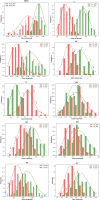Mapping of QTLs for morphophysiological and yield traits under water-deficit stress and well-watered conditions in maize
- PMID: 37223807
- PMCID: PMC10200936
- DOI: 10.3389/fpls.2023.1124619
Mapping of QTLs for morphophysiological and yield traits under water-deficit stress and well-watered conditions in maize
Abstract
Maize productivity is significantly impacted by drought; therefore, improvement of drought tolerance is a critical goal in maize breeding. To achieve this, a better understanding of the genetic basis of drought tolerance is necessary. Our study aimed to identify genomic regions associated with drought tolerance-related traits by phenotyping a mapping population of recombinant inbred lines (RILs) for two seasons under well-watered (WW) and water-deficit (WD) conditions. We also used single nucleotide polymorphism (SNP) genotyping through genotyping-by-sequencing to map these regions and attempted to identify candidate genes responsible for the observed phenotypic variation. Phenotyping of the RILs population revealed significant variability in most of the traits, with normal frequency distributions, indicating their polygenic nature. We generated a linkage map using 1,241 polymorphic SNPs distributed over 10 chromosomes (chrs), covering a total genetic distance of 5,471.55 cM. We identified 27 quantitative trait loci (QTLs) associated with various morphophysiological and yield-related traits, with 13 QTLs identified under WW conditions and 12 under WD conditions. We found one common major QTL (qCW2-1) for cob weight and a minor QTL (qCH1-1) for cob height that were consistently identified under both water regimes. We also detected one major and one minor QTL for the Normalized Difference Vegetation Index (NDVI) trait under WD conditions on chr 2, bin 2.10. Furthermore, we identified one major QTL (qCH1-2) and one minor QTL (qCH1-1) on chr 1 that were located at different genomic positions to those identified in earlier studies. We found co-localized QTLs for stomatal conductance and grain yield on chr 6 (qgs6-2 and qGY6-1), while co-localized QTLs for stomatal conductance and transpiration rate were identified on chr 7 (qgs7-1 and qTR7-1). We also attempted to identify the candidate genes responsible for the observed phenotypic variation; our analysis revealed that the major candidate genes associated with QTLs detected under water deficit conditions were related to growth and development, senescence, abscisic acid (ABA) signaling, signal transduction, and transporter activity in stress tolerance. The QTL regions identified in this study may be useful in designing markers that can be utilized in marker-assisted selection breeding. In addition, the putative candidate genes can be isolated and functionally characterized so that their role in imparting drought tolerance can be more fully understood.
Keywords: QTLs; SNPs; candidate genes; drought; physiological and yield traits.
Copyright © 2023 Sarkar, Varalaxmi, Vanaja, RaviKumar, Prabhakar, Yadav, Maheswari and Singh.
Conflict of interest statement
The authors declare that the research was conducted in the absence of any commercial or financial relationships that could be construed as a potential conflict of interest.
Figures


Similar articles
-
Mapping of QTLs associated with yield and related traits under reproductive stage drought stress in rice using SNP linkage map.Mol Biol Rep. 2023 Aug;50(8):6349-6359. doi: 10.1007/s11033-023-08550-x. Epub 2023 Jun 14. Mol Biol Rep. 2023. PMID: 37314604
-
Identification of Stable and Multiple Environment Interaction QTLs and Candidate Genes for Fiber Productive Traits Under Irrigated and Water Stress Conditions Using Intraspecific RILs of Gossypium hirsutum var. MCU5 X TCH1218.Front Plant Sci. 2022 Apr 18;13:851504. doi: 10.3389/fpls.2022.851504. eCollection 2022. Front Plant Sci. 2022. PMID: 35519814 Free PMC article.
-
Enhancing Upland cotton for drought resilience, productivity, and fiber quality: comparative evaluation and genetic dissection.Mol Genet Genomics. 2020 Jan;295(1):155-176. doi: 10.1007/s00438-019-01611-6. Epub 2019 Oct 16. Mol Genet Genomics. 2020. PMID: 31620883
-
Genetic mapping of quantitative trait loci associated with drought tolerance in chickpea (Cicer arietinum L.).Sci Rep. 2023 Oct 17;13(1):17623. doi: 10.1038/s41598-023-44990-y. Sci Rep. 2023. PMID: 37848483 Free PMC article.
-
Using genetic mapping and genomics approaches in understanding and improving drought tolerance in pearl millet.J Exp Bot. 2011 Jan;62(2):397-408. doi: 10.1093/jxb/erq265. Epub 2010 Sep 5. J Exp Bot. 2011. PMID: 20819788 Review.
Cited by
-
Breeding for resistance to maize streak virus: challenges, progress and future directions: a review.Front Plant Sci. 2025 Jun 3;16:1590870. doi: 10.3389/fpls.2025.1590870. eCollection 2025. Front Plant Sci. 2025. PMID: 40530294 Free PMC article. Review.
-
Genetic, molecular and physiological crosstalk during drought tolerance in maize (Zea mays): pathways to resilient agriculture.Planta. 2024 Aug 28;260(4):81. doi: 10.1007/s00425-024-04517-9. Planta. 2024. PMID: 39196449 Review.
-
Drought stress memory in maize: understanding and harnessing the past for future resilience.Plant Cell Rep. 2025 Apr 25;44(5):101. doi: 10.1007/s00299-025-03494-x. Plant Cell Rep. 2025. PMID: 40278890 Review.
References
-
- Almeida G. D., Makumbi D., Magorokosho C., Nair S., Borém A., Ribaut J. M., et al. . (2013). QTL mapping in three tropical maize populations reveals a set of constitutive and adaptive genomic regions for drought tolerance. Theor. Appl. Genet. 126, 583–600. doi: 10.1007/s00122-012-2003-7 - DOI - PMC - PubMed
-
- Bartlett M. S. (1937). Properties of sufficiency and statistical tests. Proc. R. Stat. Soc. Ser. A. 160, 268–282. doi: 10.1098/rspa.1937.0109 - DOI
-
- Beavis W. D., Smith O. S., Grant D., Fincher R. (1994). Identification of quantitative trait loci using a small sample of top crossed and F4 progeny from maize. Crop Sci. 34, 882–896. doi: 10.2135/cropsci1994.0011183X003400040010x - DOI
-
- Boer M. P., Wright D., Feng L. Z., Podlich D. W., Luo L., Cooper M., et al. . (2007). A mixed-model quantitative trait loci (QTL) analysis for multiple-environment trial data using environmental covariables for QTL-by-environment interactions, with an example in maize. Genetics. 177, 1801–1813. doi: 10.1534/genetics.107.071068 - DOI - PMC - PubMed
LinkOut - more resources
Full Text Sources

